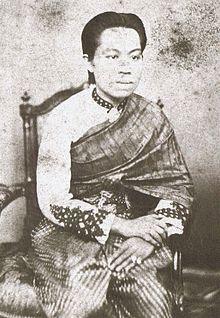Arunvadi
| Arunvadi | |||||
|---|---|---|---|---|---|
 | |||||
| Born | June 13, 1857 Bangkok, Siam | ||||
| Died | August 26, 1933 (aged 76) Bangkok, Siam | ||||
| |||||
| House | Chakri dynasty | ||||
| Father | Mongkut (Rama IV) | ||||
| Mother | Chao Chom Manda Run Supanimitr | ||||
| Signature |  | ||||
Princess Arunvadi (Thai: อรุณวดี; 13 June 1857 - 26 August 1933) was a princess of Siam (later Thailand). She was a member of the Siamese royal family and a daughter of King Mongkut of Siam and Chao Chom Manda Run.[1][2]
Her mother was Chao Chom Manda Run Supanimitr (a daughter of Kratai Supanimitr and Cham Supanimitr). She was given the full name Phra Chao Borom Wong Ther Phra Ong Chao Arunvadi (Thai: พระเจ้าบรมวงศ์เธอ พระองค์เจ้าอรุณวดี).[3]
She died on August 26, 1933, at the age of 76.[4]
Honours
 Dame Grand Commander (Second Class, upper grade) of the Most Illustrious Order of Chula Chom Klao (1899)
Dame Grand Commander (Second Class, upper grade) of the Most Illustrious Order of Chula Chom Klao (1899) Dame Commander (Second Class, lower grade) of the Most Illustrious Order of Chula Chom Klao (1893)
Dame Commander (Second Class, lower grade) of the Most Illustrious Order of Chula Chom Klao (1893) King Rama IV Royal Cypher Medal, 3rd Class (1904)
King Rama IV Royal Cypher Medal, 3rd Class (1904) King Rama V Royal Cypher Medal, 3rd Class (1908)
King Rama V Royal Cypher Medal, 3rd Class (1908) King Rama VI Royal Cypher Medal, 2nd Class (1913)
King Rama VI Royal Cypher Medal, 2nd Class (1913) King Rama VII Royal Cypher Medal, 2nd Class (1926)
King Rama VII Royal Cypher Medal, 2nd Class (1926)
References
- ^ Bradley, William Lee (1969). "The Accession of King Mongkut (Notes)" (PDF). Journal of the Siam Society. Siam Heritage Trust. JSS Vol. 57.1f. Retrieved 11 August 2013.
...alluding ... to the two Chau Fa's.
- ^ "Siamese Aristocracy : The Pisolyabutra Family". www.soravij.com. Retrieved 2023-03-30.
- ^ Reid, Anthony (2015). A history of Southeast Asia : critical crossroads. Chichester, West Sussex. ISBN 978-0-631-17961-0. OCLC 893099398.
{{cite book}}: CS1 maint: location missing publisher (link) - ^ Budziszewska, Nina (2018). "Subtler yogic consciousness as soteriological power of jñāna : From the pre-classical notions of sāṃkhya-yogic instructions in the Upaniṣads and in theMahābhārata (mahān ātman, budhyamāna and kṣetrajña) to the classical teachings of the Yogasūtras and the Sāṃkhyakārikā (Īśvara and jñāna". Thai Prajna. International Journal of Indology and Culture: 128–153.


